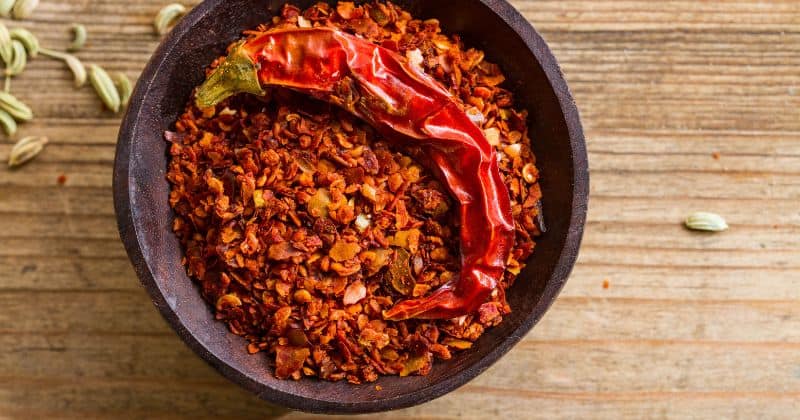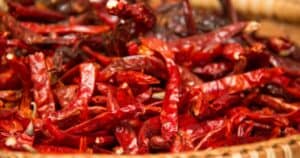Spices make meals pop. A shake of something spicy can transform an otherwise bland dish. But with so many hot toppers, it’s easy to get confused. Take red pepper flakes and chili flakes – they sound pretty similar. Are they actually the same thing? Or does each flakes variety add its own special sizzle?
Although similar, red pepper flakes and chili flakes have key distinctions:
- Ingredients – Red pepper flakes use a blend of peppers while chili flakes use one type.
- Heat level – Chili flakes are milder than red pepper flakes.
- Flavor – Red pepper flakes have a mixed taste while chili flakes highlight one pepper.
- Uses – Chili flakes suit more diners. Red pepper flakes pack more punch.
This article covers everything you need to know about these two spicy sprinkles. Let’s dive in!
A Brief History of Chili Peppers
The chili pepper’s origins trace back thousands of years to South America. Archaeological evidence shows Native Americans in Ecuador eating domesticated chilies as early as 6000 BC.
Chilies then spread through trade to Central America and Mexico, where they became integral to local cuisines. By the 15th century, Spanish and Portuguese colonists transported peppers worldwide.
Today chilies grow on every continent. Their popularity continues thanks to their addictive heat and dynamic flavors.
What are Red Pepper Flakes?
Red pepper flakes blend multiple dried, crushed peppers. This mix boosts depth and complexity. Common ingredient combos include:
- Bell peppers – For mild sweetness
- Fresno – For medium heat
- Cayenne – For intense spiciness
- Jalapeño – For green vegetal notes
The pepper medley leads to an intricate flavor with wide-ranging heat. Red pepper flakes work well in pasta, pizza, chili, and more.
What are Chili Flakes?
Chili flakes come from drying and crushing a single chili pepper variety. This creates a clear, focused flavor. Popular kinds include:
- Aleppo – Mild with fruity sweetness
- Árbol – Smoky with medium heat
- Pequin – Intense citrus-like burn
Chili flakes highlight the unique taste of their parent pepper. Many cuisines have signature chili flake blends.
How Do They Differ in Color?
Chili flakes have a uniform red color that matches their original pepper. Removing seeds and drying intensifies the hue.
Red pepper flakes range from bright to deep red. Their mixed origins lead to variation in shades from orange-red to dark crimson. Flecks of white add visual interest.
So chili flakes have a consistent red appearance while red pepper flakes show more diversity.
How Do They Differ in Flavor?
Chili flakes channel the specific flavor of one chili variety. You’ll taste characteristics like:
- Smokiness
- Citrus
- Sweetness
- Tanginess
Red pepper flakes blend multiple tastes. The combination may offer:
- Savory depth
- Sweet edge
- Sharp vegetal note
- Building heat
Chili flakes spotlight a solo flavor. Red pepper flakes produce a chorus of seasoned heat.
How Do They Differ in Heat?
Due to their blends, red pepper flakes can reach scorching levels of spiciness. Bottles often indicate the heat level, like:
- Mild
- Medium
- Hot
Chili flakes tend to sit at the lower end of the spicy scale. Their gentler kick suits
So chili flakes bring mellower heat. Red pepper flakes burn hotter.
How Are They Similar?
Though different, red pepper and chili flakes share some traits:
- Made from crushed dried peppers
- Offer flavor and heat boost
- Work in many savory dishes
- Available at grocery stores
So both provide spicy convenience for your kitchen!
Can They Be Used Interchangeably?
Red pepper flakes and chili flakes can substitute for one another. But keep these tips in mind:
- For milder heat, use chili flakes instead of red pepper flakes.
- For more complexity, use red pepper flakes in place of a single variety of chili flakes.
- Start with less when swapping to avoid overwhelming dishes.
With adjustment, both can add
Key Differences Summarized
| Red Pepper Flakes | Chili Flakes |
|---|---|
| Pepper Blend | Single Variety |
| Mixed Flavor | Focused Flavor |
| Very Spicy | Mildly Spicy |
| Varied Color | Solid Red |
Spice Up Your Meals!
Now you can distinguish these two spicy sprinkles. Chili flakes offer restrained yet robust flavor. Red pepper flakes bring blended heat.
Next time your dish needs a little zip, reach for the right flakes to add the perfect pinch of pizazz. Your food will benefit from these fun, flavorful spices!





